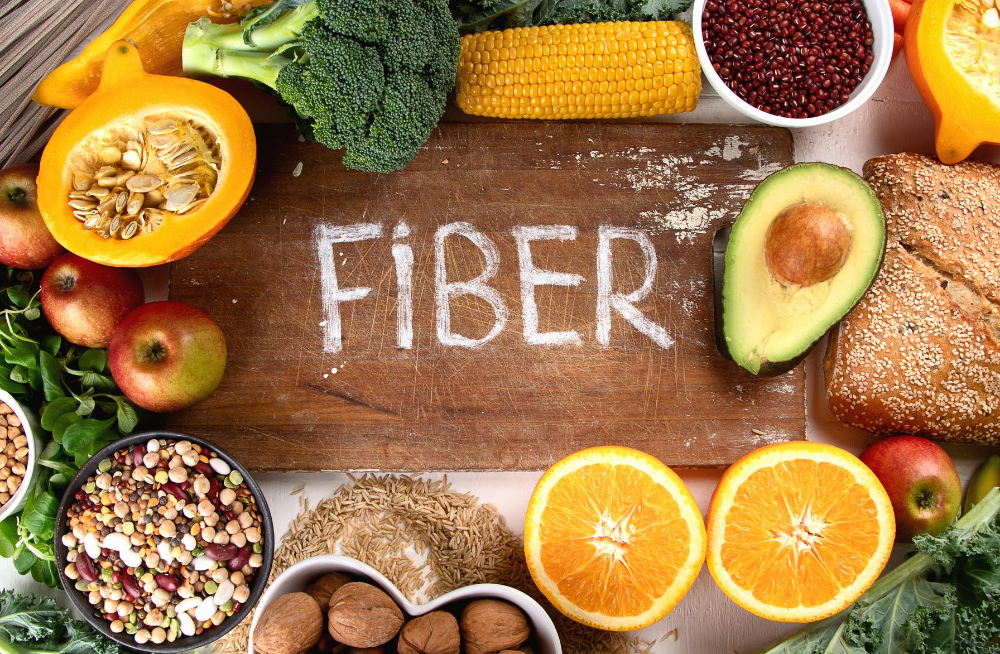
While the best way to include fibre in your diet is to eat high-fibre foods – fruits, vegetables, whole grains, beans, nuts – when this proves difficult, taking fibre supplements can help fill the gap.
While beans, whole foods or bran foods, green beans, potatoes, broccoli, and nuts are all good sources of insoluble fibre, good sources of soluble fibre include fruits, vegetables, oat bran, barley, seed hulls, flaxseed, psyllium, dried beans, lentils, peas, soy milk, and soy products. Soluble fibre dissolves in water, becomes elastic or viscous, helps eliminate fatty substances such as cholesterol, and helps regulate the body’s use of sugar. In addition, insoluble fibre reduces the time it takes for food waste to pass through the intestines.
By improving the passage of food and waste through the intestines, fibre helps the body eliminate carcinogens. Fibre can not only help you lose weight or alleviate digestive problems, but it can also lower your risk of cancer. Eating good fibre sources regularly can help stabilize cholesterol, blood sugar, and fat levels.
Fibre Content of Various Foods Dietary fibre is found naturally in grains, vegetables, fruits and nuts. Fibre can be found in all whole grains, including entire grains (such as oats, barley, rice, and wheat), beans, nuts, seeds, and whole fruits and vegetables, because fibre gives plants structure. Oat fibre can be added to smoothies, instant breakfast drinks, fruit and vegetable juices, iced teas, sports drinks, cappuccino, and wine. Other beverages that may benefit from fibre supplementation include liquid diet drinks designed for both people with special dietary needs and for weight loss or meal replacement.
Soluble fibre from grains is included in other health claims that reduce the risk of certain types of cancer and heart disease through the consumption of fruits and vegetables. Diets rich in fibre, such as diets rich in grains, fruits and vegetables, have a positive impact on health, because their consumption is related to reducing the incidence of various diseases, because it has positive effects, such as increasing stool volume, intestinal tract Reduced transit time, cholesterol and blood sugar, trapping harmful substances (mutagenes and carcinogens), stimulating the proliferation of intestinal flora, etc. Human health is summarized in the table of some of the functions and benefits of dietary fibre.
Fibre-rich meals, on the other hand, can help you maintain a healthy weight and reduce your risk of diabetes, heart disease, and several cancers. Most fibre foods are also good sources of vitamins, minerals, and antioxidants, which provide many health benefits.
Fibre is a structural part of plant foods (such as fruits, vegetables, and grains), and our body cannot digest or break down these foods. Fibres are generally classified as soluble, that is, water-soluble, or insoluble, that is, insoluble. One way to classify fibre types is through their water solubility.
The content of soluble and insoluble fibre in different plant foods is different. Plant foods contain different amounts of two types of fibre, depending on the viscosity and fermentation capacity of the fibre. Both types of fibre are found only in plant foods: meat and dairy products do not contain natural fibre.

If you are looking to lose weight, eating foods that are high in fibre are your best bet. You are probably already familiar with the importance of eating enough fibre, which, among other benefits, can help reduce your risk of heart disease, diabetes, and colon cancer. This guide contains essential information to help you increase the amount of fibre in your diet. Learn more about fibre and weight loss, as well as why you should consume more of these seven high-fibre foods.
While reaching your daily goal may seem overwhelming at first, consuming whole grains, vegetables, fruits, and whole grains can provide you with the fibre you need for health benefits.
To get the most fibre and gain the health advantages, it’s best to eat as many diverse meals as possible. Below are seven types of fibre and foods in which you can find them.
Lignin, cellulose, and hemicellulose are common types of insoluble fibre, and food sources include wheat bran, vegetables, fruits, and whole grains. Soluble fibre comes in the form of pectins and gums, which can be found in oat bran, barley, nuts, seeds, beans, lentils, peas, and some fruits and vegetables. Soluble Fibre – These fibres dissolve in water, forming a viscous gel in the gastrointestinal tract, which helps slow the digestion and absorption of glucose.
Soluble fibre can slow down the release of sugars from digested food into the blood, thereby preventing rapid rise in blood sugar levels. Insoluble fibre, or fibre that is insoluble in water, aids digestion by assuring regularity and reducing constipation.
All portions of plant meals that cannot be digested or absorbed by the body are referred to as “fibre”. Fibre is simply a type of carbohydrate that is naturally found in plant foods and cannot be absorbed by humans.
Many foods contain different types of dietary fibre, and they promote health in different ways. Whole plant food contains many different types of molecules, which belong to the definition of fibre. Cellulose (the major component of plant cell walls), hemicelluloses (cereal fibres), and lignin are all examples of insoluble fibres (polysaccharides).
This is the best fibre for constipation because it helps to draw water into the stool to soften the stool and help speed up the transit time. This type of fibre helps move matter through the digestive system and increase stool quality, so it may be helpful for people with constipation or irregular bowel movements. It is a crude fibre that helps prevent constipation and is found in whole grains, wheat, and vegetables (such as carrots, celery, and tomatoes). Soluble fibre also binds to fatty acids to eliminate them from the body and help lower low-density lipoprotein (bad) cholesterol.
Soluble fibre is hypothesised to reduce blood cholesterol levels by binding and excreting bile acids (which are generated from cholesterol to breakdown dietary fat). A diet high in soluble fibre can also help lower blood cholesterol, because soluble fibre binds cholesterol and bile acids (containing cholesterol) in the gastrointestinal tract.
